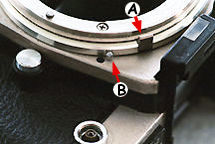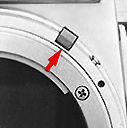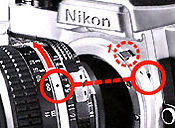BEFORE proceeding to sections to follow, a little summary relating to AI and Non-AI issues. Skip these if you are very well verse with what these technicalities are all about.
I don't remember exactly what was I doing during the year 1977. Perhaps it may not be as significant to me, but to Nikon that was the year they introduced a new series of AI-Nikkor lenses and new camera bodies were introduced. Prior to the arrival of this new method automation of full aperture metering, Nikkor lenses communicate lens aperture settings to the camera body via a metal meter coupling prong on the lens (or more commonly referred as rabbit ears). On the camera body, it has a metal projecting out to mate with the prong which is called meter coupling pin.
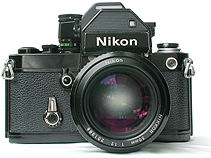 |
An AI-Nikkor 50mm f/1.2 lens is mounted on a Non-AI Nikon F2S body. The AI-Finders introduced later (DP-11 & DP-12) permit the use of AI or Non-AI Nikkor lenses where older non-AI optics are still usable in stopped down exposure measurement. It is a wrong perception to think a Nikkor lens without the meter coupling shoe atop the lens's aperture ring cannot be used on a Non-AI camera body. They still can be mounted and use EXCEPT the metering guide displayed may not be applicable. You have to use them it entirely in full manual mode. |
I don't know why it was called "Indexing" where those days, whenever a lens is mounted onto the camera body, it is necessary to perfectly fit the pin into the slot on the meter coupling prong on the lens section in order to cause the lens to set to its maximum aperture. This in turns, provides a bright viewfinder image for easy focus and picture composing. Those older lenses are usually called "auto Nikkor" lenses. In 1977, Nikon introduced a new way to automate such process with a method called "AI" (short for "Automatic Indexing" or "Automatic Maximum Aperture Indexing") which enables a faster way to handle lens changing without the hassle of manually set the lens and body together.
 |
The Nikkor lenses introduced after 1977 came with AI-spec and featured an additioal protruding metal ridge near the lens mount which is called meter coupling ridge and it works with the meter coupling lever on the camera side and they will mated perfectly and automatically once such a AI-lens is mounted with an AI-spec camera body to enable automatic maximum aperture for proper camera built-in metering to function correctly |
Virtually all older series of AI-spec Nikkor lenses also retain the Meter Coupling Shoe so as they can still be work with older non-AI camera bodies. These lenses has both a meter coupling prong and the meter coupling ridge and thus they can be used for both AI and non-AI bodies. So, that is why I always emphasize it worth to pay a little premium to invest into an AI-spec lens for better compatibility. The MOST important fact you need to know is, to use older Nikon camera models, you will need a lens that still has the meter coupling shoe atop the aperture ring in order to enable the older method of indexing works for metering.
Some of the AI-spec Nikkor lenses introduced in later stages such as Nikon Series E lens family and ALL the current AF-Nikkor optics are NOT advisable to use with a non-AI camera such as the F2 Photomic, F2S and F2SB featured earlier (although they can still be mounted on the camera and in many instances, Stopped Down Exposure measurement is equally accurate).
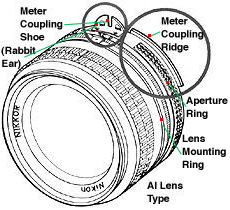 |
To use a NON-AI lens with a AI-spec camera body would require the camera to use a different metering method called stopped down exposure measurement via depressing the depth of field preview button on a Nikon F2 camera body to meter using working aperture get exposure guide correctly (The viewfinder will dim or darken when smaller aperture is used, you will then use the match needle OR LEDs to get an exposure reference guide). |
To retain the modular design of the F2 camera body, the AI coupling for the Nikon F2A and F2AS (w/DP-11 and DP-12 respectively) was built under the finder and it needs not have to make use of the meter coupling prong on the Nikkor lenses anymore as with the non-AI finders of DP-1, DP-2 and the DP-3.
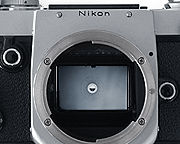 |
On the camera side, there is NO changes made on the lens mount on the F2A and F2AS. |
|
<<< ---- Lens mount of a Nikon F2 and Nikon F3, 1980 has the AI feature incorporates into the lens mount ---->>>
Well, it is also different from the rest of other Nikon bodies that introduced at the same time with the newly introduced indexing method, the other three models are Nikkormat FT-3, Nikon EL2* and the compact Nikon FM where the AI-coupling is built-in the lens mount and form an integral part of the camera body. The AI feature is actually incorporated at base of the metered finder DP-11 and DP-12. Technically, you can just mount a DP-12 finder onto a 1973 Nikon F2 camera and called it a F2AS but seasoned Nikon followers or collector would make use of the series number to track an actual F2A or F2AS by the starting number of #77xxxxxx as both of the AI-spec F2 models were only being introduced after 1977 and only discontinued in 1980.
* Nikkormat FT-3 was the last of the Nikkormat series to retain trade name of "Nikkormat"; the electronic EL-2 was the first Nikkormat to use the unified "Nikon" trade name for their subsequent camera models.
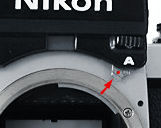 |
 |
The five Nikon camera models introduced have three separate AI-design at the lens mount section: |
The F2A and F2AS has its coupling built-in the finder; the Nikkormat FT-3 and EL-2 were also different as it adds AI to the shutter speed ring which is also at the lens mount; the more straight forward is the Nikon FM which can regard as the first Nikon body to use the AI-lens mount design.
In 1979, Nikon made a controversial decision when they introduced a 'budget' ultra-compact size Nikon EM camera where the camera has a fixed meter coupling lever which means from then on, ALL midrange Nikon camera models will not be supporting non-AI lenses. That was a clear commercial decision but fortunately, the top of the line F-series models (F3, F4) maintain such tradition of providing full backward compatibility* with non-AI lenses via lens mount that still retained the retractable meter coupling lever.
OFF-TOPIC SUPPLEMENTS (ONLY applicable to models Nikkormat FT-3, Nikon EL-2, Nikon FM, Nikon FE, Nikon F3, Nikon F4 and Nikon F5 (factory Modification required):
* WARNING: A minimum spec of AI'd (AI Modified) Nikkor lens is required to enable full aperture metering function. To use non-AI lenses with F3/F4 (F5 requires a factory modification), exposure control is limiting to stopped-down metering/exposure measurement. NEVER retract the lever if an AI lens is used with such cameras (including Nikkormat FT-3, Nikon EL, Nikon FM and Nikon FE), as erroneous exposures will result. |
| Previous | Next | 10/17 The AI-version of the DP-1 finder - DP-11
| Back | Main Index Page - Interchangeable Viewfinders
System
Accessories:
Motor
Drives
/ Prisms / Screens / Macro / Film
Backs
/ Flash
Other Accessories:
DS-1 / DS-2 / DS-12 / eyepiece / DH-1 / cases / Cable releases / Miscellaneous
| History
& Background
| Semi-FAQ | Various Features and Functions - 6 Parts |
| Message Board | for
your favourite Nikon
F2 Series SLR model(s)
| Message Board | for your Nikon Optics in a shared environment
| Message Board | Specifically for Dispose or Looking for Nikon/Nikkor Photographic
Equipment
| Back | to Main Index Page of Nikon F2 Series SLR models
| Back |
Main Index Page of Pictorial History of Nikon SLRs
 |
The Eyes of Nikon:- |
Fisheye-Nikkor Lenses - Circular | Full Frame | Ultrawides Lenses - 13mm15mm18mm20mm | Wideangle Lenses - 24mm28mm35mm |
Standard Lenses - 45mm 50mm 58mm | Telephoto Lenses - 85mm105mm135mm180mm & 200mm |
Super-Telephoto Lenses - 300mm 400mm 500mm 600mm 800mm 1200mm |
Special Application lenses:
Micro-Nikkor Lenses - 50mm~55mm -60mm 85mm -105mm 200mm Micro-Zoom 70-180mm
Perspective Control (PC) - 28mm 35mm PC-Micro 85mm
Dedicated Lenses for Nikon F3AF: AF 80mm f/2.8 | AF 200mm f/3.5 EDIF
Depth of Field Control (DC): 105mm 135mm
Medical Nikkor: 120mm 200mm
Reflex-Nikkor Lenses - 500mm 1000mm 2000mm
Others: Noct Nikkor | OP-Nikkor | UV Nikkor 55mm 105mm | Focusing Units | Bellows-Nikkor 105mm 135mm
Nikon Series E Lenses: 28mm35mm50mm100mm135mm | E-Series Zoom lenses: 36~72mm75~150mm70~210mm
MF Zoom-Nikkor Lenses: 25~50mm | 28~45mm | 28~50mm | 28~85mm | 35~70mm | 36~72mm E | 35~85mm | 35~105mm | 35~135mm |
35~200mm | 43~86mm | 50~135mm | 50~300mm | 70~210mm E | 75~150mm E | 80~200mm | 85~250mm |
100~300mm | 180~600mm | 200~400mm | 200~600mm | 360~1200mm | 1200~1700mm
Tele-Converters: TC-1 | TC-2 | TC-200 | TC-201 | TC-300 | TC-301 | TC-14 | TC-14A | TC-14B | TC-14C | TC-14E | TC-16 | TC-16A | TC-20E
![]()
Nikon F
| Nikon F2 |
Nikon
F3
| Nikon F4 |
Nikon
F5
| Nikon F6 |
Nikkormat / Nikomat |
Nikon FM
| Nikon FE/ FA | Nikon EM/FG/FG20 | Nikon Digital SLRs | Nikon - Other models
MIR Supports for Photographic Community: Various Message Boards/Community
Forums
Nikon
F-series|
Nikon
F2-series|
Nikon
F3-series|
Nikon F4-series| Nikon
F5-series|Nikkormat/Nikomat-series
Nikon FM-series|Nikon
FE-series|Nikon
FA|Nikon
Digital
SLR
series|Various
Nikon
Models|Nikkor
Optic
-shared
Others:- Free Trade Zone - Photography| Free Trade Zone - Business Community |Free To Zouk - Photographic Community
Apple's Mac Public Community Message Board | Windows based PC &
Apple/Mac
Public Community Trade Exchange Centre
Recommended links to understand
more technical details related to the Nikkor F-mount and production Serial Number:
http://rick_oleson.tripod.com/index-153.html by: my friend, Rick Oleson
http://www.zi.ku.dk/personal/lhhansen/photo/fmount.htm by: Hansen, Lars Holst
http://www.mir.com.my/rb/photography/hardwares/nikonfmount/lens2.htm
http://www.photosynthesis.co.nz/nikon/serialno.html
About this photographic site.
HOME - Photography in Malaysia |
Copyright © 2000. leofoo ®. MIR Web Development Team.
In
memory of my friend Com.
Augusto Staut,
Brazil, 1971-2000.
Credit: Chuck Hester, US for his patience, encouragement
and help to setup the various content in this site; Robert Johnson for some of his original
images on the F2H-MD appeared in this site; my ex-staff, KiaSu for his superb
3-D logo appeared in this Nikon F2 site; Marc Vorgers from Holland who
generously provide me with some of his images of F2AS; MCLau®, who has so much time with me to
re-edit the content in this site and not to mention buying a Nikon Coolpix 990 just
for this site. Keat Photo,
Kuala Lumpur for providing
their Nikon F2A to take some images for this site; again, Mr Edward Ngoh the
great camera collector who provides us his collection of F2AS with MD-2; hawkeye.photographic.com
for their images on the Speed Magny film backs; Sean Cranor for his image
on Nikon F2 25th Anniversary Model; Ted Wengelaar®, Holland for his continuous
flow of input on some of the early Nikon bodies; CYLeow ® , photo editor of the Star
newspaper, Malaysia for some of his images used in this site. Ms Rissa Chan, Sales manager from
Shriro Malaysia who has helped to provide some of the very useful input. HiuraShinsaku®,
Nikomat ML, Japan for some of his images on various F2 models; my staff, Wati, Maisa, Mai and my nephew, EEWyn®, who volunteered and helping me
did so many of the film scanning works. Contributing photographers or resellers:
Jen Siow, Foo KokKin, Arthur Teng, Mark Fallander, John
Ishii, Ed Hassel, YoonKi Kim, Jean-Louis, M.Dugentas (Dell Corner.com.), Mr "Arsenall" and a few images mailed
in from surfers with no appropriate reference to their origin. Dedicated to KU Yeo, just to express our mutual regrets over the outcome of
a recent corporate event. Made with a PowerMac, broadcast with a Redhat Linux powered server.
![]()
![]()
